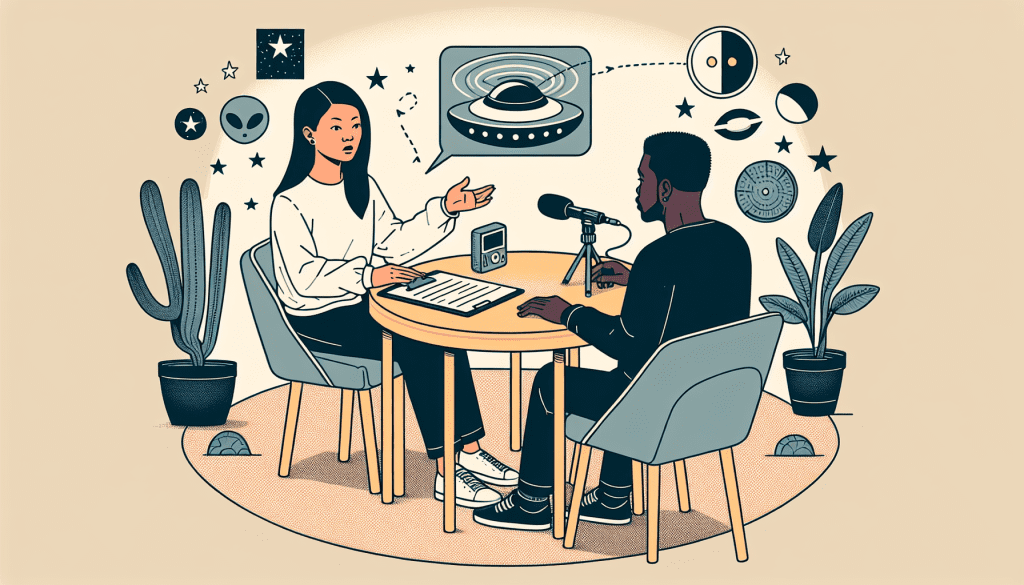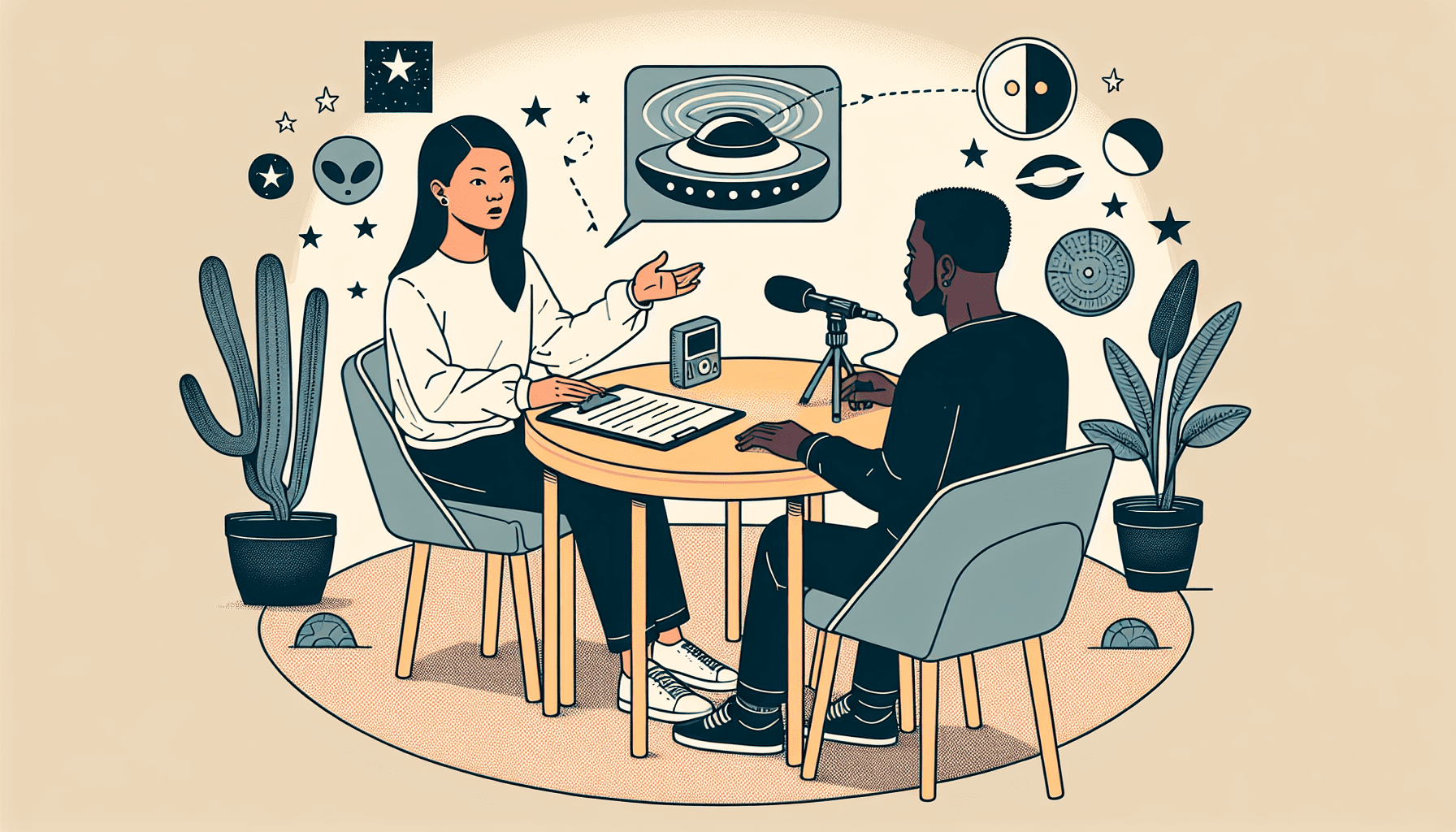In this article, you’ll discover the most effective ways to conduct UFO witness interviews. Whether you’re a researcher or simply curious about these unexplained phenomena, understanding the best practices will not only help you gather accurate and detailed information, but also provide a comfortable and supportive environment for the witnesses to share their extraordinary experiences. So, get ready to uncover the essential techniques that will set you on the path to uncovering the truth behind these captivating encounters.

Building Rapport with the Witness
Maintaining a calm and empathetic demeanor
When conducting a UFO witness interview, it is crucial to establish a calm and empathetic demeanor from the very beginning. By approaching the witness with a friendly and understanding attitude, you create a safe space for them to share their experiences. Remaining calm yourself helps alleviate any potential anxiety or nervousness the witness may be feeling, allowing for a more open and honest conversation.
Establishing trust and credibility
Building trust with the witness is necessary to ensure they feel comfortable sharing their encounter. Be transparent about your intentions, explain the purpose of the interview, and assure them that their perspective is valued. To establish credibility, share relevant qualifications or expertise you may have. Showing a genuine interest in their story and creating an environment of mutual respect is key to fostering trust.
Active listening and non-verbal communication
Active listening is a fundamental skill when conducting any type of interview, especially when it comes to UFO sightings. Give the witness your undivided attention by maintaining eye contact, nodding, and providing verbal cues that you are fully present. By actively engaging in the conversation, you convey your genuine interest and respect for their story. Non-verbal cues such as leaning forward and adopting an open body posture can further enhance rapport and encourage the witness to feel comfortable sharing their account.
Preparing for the Interview
Understanding the background and context of the sighting
Before conducting the interview, it is essential to gather background information about the sighting. Research the location, time, and any relevant historical or environmental factors that may have an impact on the witness’s experience. Understanding the context helps you approach the interview with a more informed perspective and enables you to ask targeted questions that address specific aspects of the sighting.
Reviewing any previously collected evidence
If any evidence has been previously collected, such as photographs, videos, or written statements, thoroughly review and analyze them. This step allows you to better understand the witness’s perspective and potentially identify inconsistencies or areas that require further clarification. By familiarizing yourself with the existing evidence, you can approach the interview with a more comprehensive understanding of the sighting.
Gaining familiarity with common UFO phenomena
Acquaint yourself with common UFO phenomena to better comprehend the witness’s account. Familiarize yourself with various types of sightings, such as lights in the sky, triangular or saucer-shaped objects, or unidentified aerial phenomena. This knowledge enables you to ask informed questions and draw connections between the witness’s experience and existing UFO literature. By demonstrating your understanding of the topic, the witness is more likely to perceive you as a credible interviewer.
Creating a Comfortable Environment
Choosing an appropriate location for the interview
Selecting an appropriate location for the interview is crucial to ensure the witness feels comfortable and at ease. Opt for a quiet and private space where the witness can freely express their thoughts and emotions without fear of judgment or distractions. The location should be neutral and devoid of any potential triggers that may hinder the witness’s ability to recall their sighting accurately.
Ensuring privacy and minimizing distractions
To create a comfortable environment, it is essential to guarantee privacy and minimize distractions during the interview. Choose a time and place where interruptions are unlikely, such as a secluded room or private office. Ask the witness to turn off their phone or any other potential distractions, allowing for undisturbed focus and concentration throughout the interview. By eliminating external disturbances, you can maximize the quality of the conversation.
Providing necessary comforts and amenities
Consider the comfort of the witness during the interview. Provide amenities such as water, tissues, or any other items that may contribute to their physical comfort. A warm and welcoming atmosphere helps the witness relax and open up about their experience. Small gestures like offering a comfortable chair or a warm beverage can go a long way in making the witness feel at ease and valued.
Interview Structure and Techniques
Using open-ended questions to encourage detailed responses
When conducting the interview, focus on using open-ended questions to elicit detailed and descriptive responses from the witness. Open-ended questions allow the witness to provide more information and give context to their sighting. Avoid questions that can be answered with a simple “yes” or “no” to encourage the witness to share their experience fully. By using open-ended questions, you provide the witness with the opportunity to express themselves freely and narrate their encounter in their own words.
Applying active and reflective listening techniques
Active listening involves paying close attention to the witness’s words, tone, and emotions. Reflect back on what the witness has shared to demonstrate your understanding and validate their experience. Summarize their account periodically to show that you are actively engaged in the conversation. Active and reflective listening techniques help build trust and rapport by conveying that the witness’s story is truly being heard and respected.
Avoiding leading or suggestive questions
To maintain the integrity of the witness’s account, it is crucial to avoid leading or suggestive questions. Leading questions can unintentionally influence the witness’s responses, potentially leading to inaccurate or biased information. Instead, focus on neutrally phrased questions that allow the witness to recall their encounter without guidance or prejudice. By refraining from leading questions, you create a foundation for reliable and authentic testimony.
Documenting the Witness’s Account
Taking detailed notes or using audio/video recording
To ensure accuracy and preserve the witness’s account, it is essential to take detailed notes or consider audio/video recording the interview. Document the conversation in a clear and organized manner, capturing significant details, timelines, and any other relevant information shared by the witness. Audio/video recording provides an additional layer of accuracy and can be used for reference during analysis or future investigations.
Capturing the sequence of events
Ask the witness to recount the sequence of events in chronological order. Capture the precise details of what they saw, heard, and experienced as accurately as possible. Encourage the witness to include any notable landmarks, time references, or interactions they may have had during the sighting. By capturing the sequence of events, you create a comprehensive narrative that aids in further analysis and understanding.
Recording the witness’s emotional state and physical reactions
In addition to capturing the factual details of the sighting, it is essential to document the witness’s emotional state and physical reactions. Pay attention to any changes in their tone of voice, body language, or facial expressions as they recount their experience. By recording the witness’s emotions and physical reactions, you gain valuable insights into the impact of the sighting on their well-being and credibility.
Validating the Witness’s Credibility
Assessing the witness’s background and expertise
To evaluate the witness’s credibility, assess their background and expertise in relevant areas. Understand their educational or professional background to gauge their understanding of natural phenomena and the potential for misidentification. Additionally, inquire about any previous involvement with UFO sightings or paranormal experiences. Assessing the witness’s background and expertise provides a broader context for their account and aids in credibility assessment.
Checking for consistency in the witness’s account
Consistency is a key factor when evaluating a witness’s credibility. Look for consistency within their account, comparing it to any evidence or statements provided. Analyze if the witness’s narrative remains stable throughout the interview and if there are any discrepancies or contradictions that require clarification. While slight variations are expected, consistent details help validate the witness’s account.
Verifying the witness’s track record with other sightings
If the witness has reported multiple sightings or encounters in the past, it is worth exploring their track record. Investigate if their previous accounts align with established UFO literature or if their claims have been debunked or scrutinized by experts. Verifying the witness’s track record with other sightings adds another layer of credibility assessment and aids in gaining a more comprehensive understanding of their reliability.
Handling Emotional Responses
Providing emotional support and reassurance
Witnesses of UFO sightings may experience a range of emotions, including fear, confusion, or excitement. It is crucial to provide emotional support and reassurance throughout the interview. Listen attentively, acknowledge their emotions, and offer empathy and understanding. Assure them that their feelings are valid and that their experience is being taken seriously. Your supportive approach helps the witness feel safe and understood.
Validating the witness’s emotions and experiences
Validating the witness’s emotions and experiences is essential during the interview. Acknowledge the impact the sighting has had on their emotional well-being and assure them that their feelings are valid. By recognizing and validating their emotions, you create an environment of trust and demonstrate your commitment to understanding their encounter holistically.
Referring to support groups or experts if needed
If the witness’s emotional response appears to be significantly impacting their well-being, consider referring them to support groups or experts who specialize in UFO sightings or traumatic events. These professional resources can provide additional guidance, counseling, or support services beyond the scope of the interview. By offering appropriate referrals, you demonstrate a genuine concern for their well-being and ensure they receive the necessary assistance.
Assessing Potential Explanations
Exploring alternative explanations beyond UFOs
While conducting the interview, it is crucial to explore alternative explanations beyond UFO sightings. Consider natural phenomena or man-made objects that could potentially account for the witness’s experience. Encourage the witness to reflect on possible alternative explanations and discuss any additional observations that may aid in understanding the sighting from different angles. By exploring other possibilities, you contribute to a comprehensive and thorough investigation.
Considering natural phenomena or man-made objects
As part of assessing potential explanations, consider natural phenomena or man-made objects that could resemble the witnessed phenomena. Familiarize yourself with common meteorological, astronomical, or atmospheric events that might have created similar visual or auditory effects. Inquire about any nearby military or civilian operations that could have caused unusual sights or sounds. Considering natural phenomena or man-made objects widens the investigative scope and enhances the credibility of the inquiry.
Consulting experts in various relevant fields
To gain further insights and perspectives, consult experts in fields such as astronomy, physics, psychology, or meteorology. Their knowledge and expertise can provide valuable context, validation, or explanations for the witnessed phenomena. Seek expert opinions that align with their respective fields, allowing for a more informed assessment of the sighting. Consulting experts enhances the overall credibility and reliability of the investigation.
Analyzing the Evidence and Testimonials
Assessing the credibility and reliability of evidence
When analyzing the evidence collected during the investigation, it is crucial to assess its credibility and reliability. Scrutinize any photographs, videos, or physical evidence for signs of manipulation or tampering. Consider the source of the evidence and evaluate the witness’s proficiency in capturing or documenting the phenomena. By examining the evidence critically, you can determine its value in supporting the witness’s account.
Cross-referencing with other witness accounts or reports
To strengthen the reliability of the witness’s account, cross-reference it with other witness accounts or reports. Seek out additional witnesses who may have observed the same or similar phenomena. Compare their testimonies and identify any shared details or patterns. Corroborating witness accounts provide a stronger basis for the validity of the sighting and contribute to a more comprehensive understanding.
Consulting experts in image or video analysis
If photographic or video evidence is available, consider consulting experts in image or video analysis. These professionals possess specialized skills to scrutinize the authenticity and integrity of visual evidence. Through detailed examination, they can identify any potential signs of manipulation, offer insights into image quality or lighting, and contribute to an accurate assessment of the evidence. Consulting experts in image or video analysis strengthens the credibility of the investigation.
Maintaining Confidentiality and Anonymity
Respecting the witness’s privacy and confidentiality
Throughout the interview process, it is essential to respect the witness’s privacy and confidentiality. Assure them that their personal information will be kept confidential and only shared with relevant parties involved in the investigation. Obtain their explicit consent to disclose any identifying details if needed and explain the purpose and scope of the disclosure. Respecting the witness’s privacy fosters trust and encourages open communication.
Obtaining permission for publication or sharing
Before publishing or sharing any information about the witness or their account, obtain their explicit permission. Clearly explain how the information will be used, whether it is for research, educational purposes, or public awareness. Provide a written consent form that outlines the specific details and limitations of the publication or sharing process. Obtaining permission ensures ethical standards are met and protects the witness’s rights.
Using pseudonyms or initials to protect identities
To further protect the witness’s identity, consider using pseudonyms or initials instead of their real names when documenting or publishing the account. This precautionary measure adds an extra layer of confidentiality and privacy. Inform the witness about the pseudonym or initials you plan to use and ensure they are comfortable with this approach. By safeguarding identities, you maintain the confidentiality of the witness and uphold ethical standards in UFO witness interviews.
In conclusion, conducting effective UFO witness interviews requires building rapport with the witness, preparing thoroughly, creating a comfortable environment, using appropriate interview techniques, documenting the account accurately, validating the witness’s credibility, handling emotional responses, assessing potential explanations, analyzing evidence, and maintaining confidentiality. By following these best practices, investigators can gather reliable information, further our understanding of UFO sightings, and provide support to witnesses who have had extraordinary experiences.

